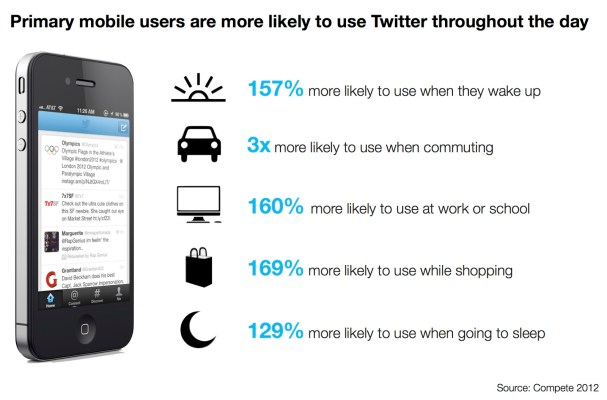Twitter released the details of a new study about its “primary mobile users,” or those who engage with Twitter more on mobile devices and on the mobile web than on the desktop. The study, commissioned by Twitter from Kantar Media’s Compete, revealed that Twitter’s mobile-first users are more engaged than mobile users in more ways than one, skew younger, and tend to be more receptive to branded content than their desktop counterparts.
Primary mobile users are 57 percent less likely to log into Twitter on the desktop than the average Twitter user, but they check the service much more frequently than most; they’re around 86 percent more likely to be active on Twitter several times a day than the average user. They’re mostly coming in by way of smartphone apps, but a considerable 15 percent of those who are primarily mobile users access by tablet first and foremost.
Users who are mobile-first end up being younger than the average Twitter user, too, the study found. Users in the 18-34 range are 52 percent more likely to log in primarily via a mobile device than other age groups. They’re also more likely to check in with the service as a means of book-ending their day, being 157 percent more likely than average to open Twitter when waking up, and 129 percent more likely to do so when going to sleep for the night. They’re also 160 percent more likely to use Twitter at school or at work, 169 percent more likely to use the service while shopping, and three times as likely to use it when commuting or before or after seeing a movie.
Twitter members who do mobile more than other methods are also 57 percent more likely to create original tweets, 63 percent more likely to click links, 78 percent more likely to retweet and 85 percent more likely to favorite tweets. In general, they’re more willing to engage with the content of others and of brands, since users who are mostly mobile are 96 percent more likely to follow 11 or more brands, and 58 percent more likely ro recall seeing a Twitter ad, according to the data from Compete.
Here’s the uptake: Twitter is clearly looking at increasing its mobile advertising juice, and these numbers provide it with some great ammunition to help with that goal. They basically indicate that in sum, users who prefer to access Twitter mostly on mobile are the perfect demographic for targeted campaigns, since they’re more motivated than most to see and take note of content, to create their own content (user-generated content is a key component of Twitter’s value proposition for advertisers, after all), and just generally prone to having their eyes on tweets whenever they may be posted.
